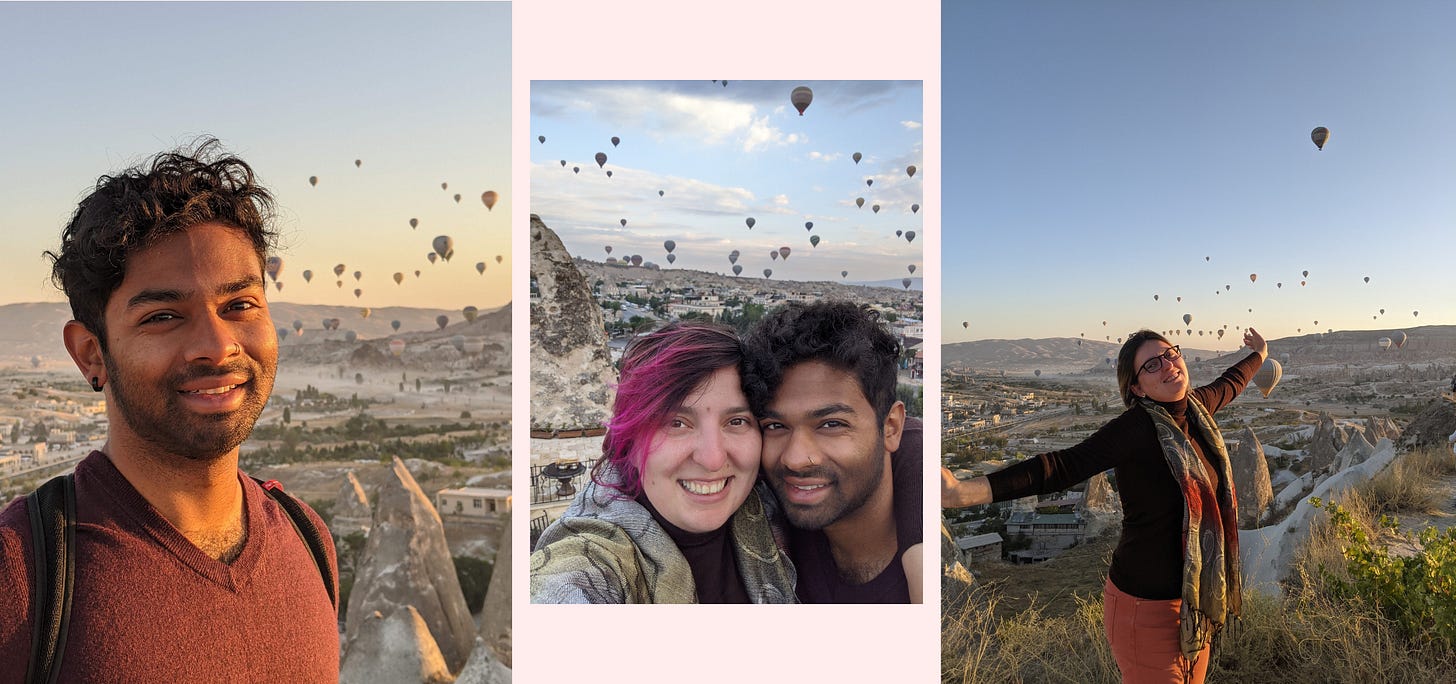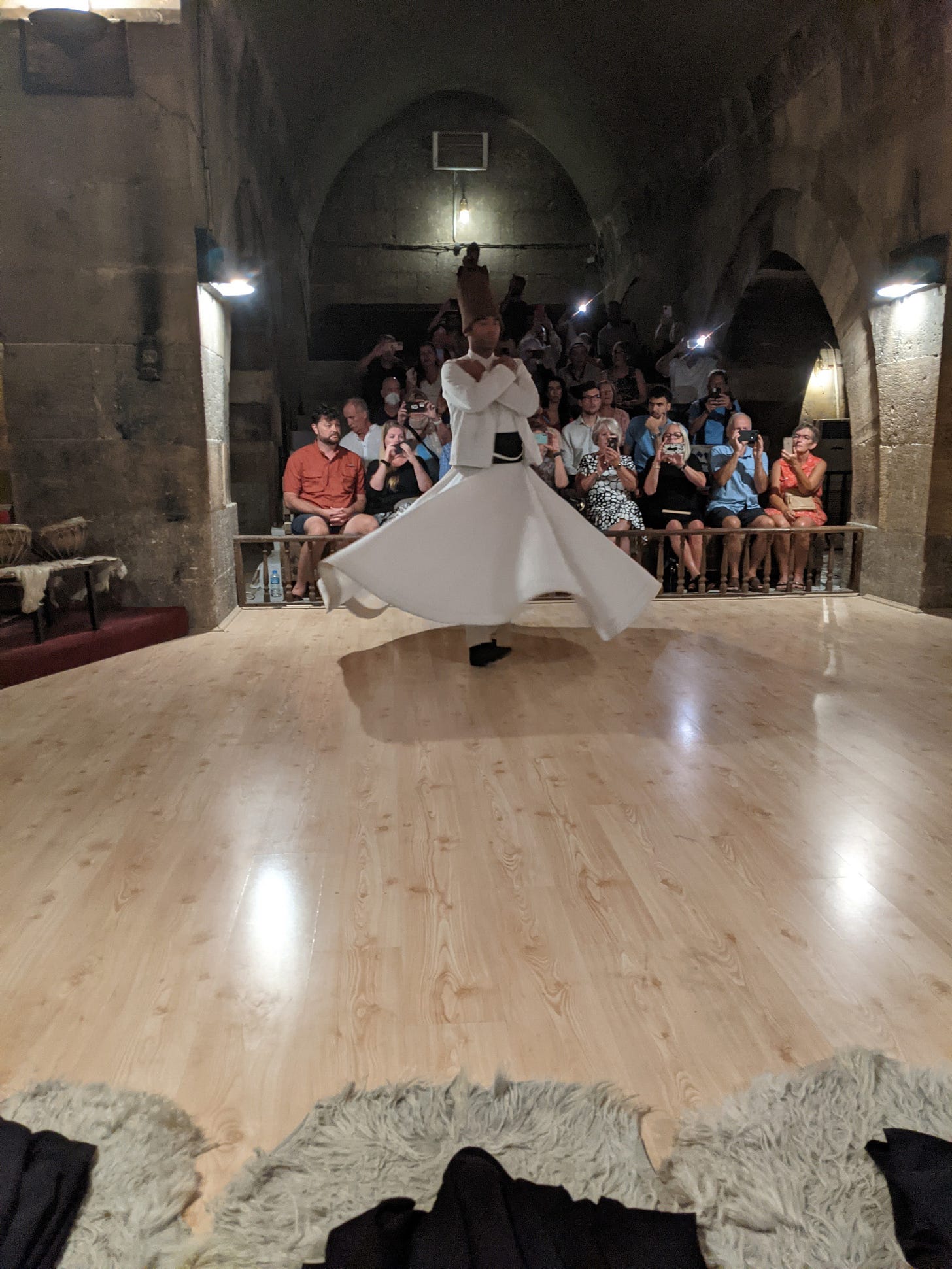Cappadocia has charmed countless civilizations for many generations.
To the Hittites, this was the Land of Good Grapes and Wine. To the Persians, it was the land of Good Horses. To the Instagrammers, it's the land of good poses from hot air balloons.
To me, it was a beautiful lesson on geography and how everything inevitably changes.
Also, let me not be hasty here, I can appreciate the “Land of Wine” part.
There are strains of grapes here that I have never tasted in wine before, and they were all delicious. All sorts of grape varieties grow here using the very precious ammonia nitrate from pigeon poop. Pigeon valley and many other mountains and rock structures were fitted with pigeon homes, small circular avian AirBnBs, to make sure the area is hospitable to the creatures and their golden poops, which keep the land fertile. (As a member of Bat Conservatory International, I remain a devoted fan of bats and their nitrate-rich excrements, but guano is too rich and would not in fact make the soil better for grapes). Anyways, that is why the region continues to be a first-class hangout for pigeons.

Back to my mind being blown by the geography: The top of Cappadocia is the floor of an ancient lake. Those plateaus? That's the bottom of the lake. The funny conical structures that did not erode as quickly as the rest of the former plateaus — they are old veins of volcanic rock that sprang up in that ancient lake. The most complete pieces even have a little rock on top, balanced as a sort of cork: known as hoodoos. The entire structures are also known as "fairy chimneys," and they look amber and orange in the sunsets of Cappadocia.
It's so enchanting: the vegetation is sparse, but the hills and various levels of receding rock transform the canyons into mysterious spaces worth exploring. Aseef and I explored on horseback. It was a two-hour ride around sunset, done in a slow loop. The handlers of the horses — guys that have cared for and ridden horses since they were four years old — are literally walking beside you. We did see a few ladies get disappointed: they had come from a hair appointment to prepare for a horseback engagement photoshoot or to pose like “proper influencers” with flowing hair on a wild ride, but the mandatory protective hair nets and helmets were strictly enforced. After some basic instructions on egging the horses onward or to a stop, we were allowed to slowly amble along. I wasn't trusted to have free reign with my horse, but it was easy to look around and enjoy the ride. Yeah.. Maybe 'ride' is too strong a word. It was more than those merry-go-rounds where ponies are tied to a post at fairs. But also… the guy leading my horse was walking slowly enough to chain smoke half a pack of cigarettes. It was quite a relaxed adventure.

I thought the horses — maybe not direct descendants from the 'fine horses' that the Persians found in these lands — were gorgeous and a little melancholic. Maybe they always look a little sad, given their big eyes. Aseef had a hard time seeing their charms, focusing a lot more on their prolapsing rectums, but I tell you: they were majestic creatures, and focusing on other details is horse shit. The menace of the Cappadocia sunset is the columns of ATVs that roar through the valley, kicking up dust. They pass so often, they tend to forge their own paths at the risk of the natural environment. Our horses were pros though, and remained unspooked by them.
Some of the canyons we rode around had interesting erosions from animals and weather — and some man-made carvings that look like bedrock palaces rising out of the ground.
We were lucky enough to stay in a cave hostel in Göreme: rooms carved out in the bedrock many, many centuries ago. They were pitch dark. But naturally cool in spite of the hot summer days, and usually offered wonderful platforms to view the hot air balloons in the morning.

I loved the dwellings in Cappadocia. Especially the older buildings. But it’s clear the area is changing pretty quickly. Aseef visited a month before returning with me, and he noticed tons of progress on a new strip mall in the center of Göreme. Roadwork in a lot of the more touristy towns is constant. One guide posited that the current government is pretty interested in approving construction from whoever’s got money, and the tourist-heavy parts of Cappadocia certainly have a steady stream. We hope all the growth will still preserve the natural beauty of the region. I know, I know, I sound like some crotchety person averse to all change, but with great civilian development comes a great risk to natural conservation efforts. It’s easy to see that people will pay to build up the area, and less funds are likely to come in to preserve the hills and hoodoos.
Oh, that reminds me. There's another little-known risk in Cappadocia… the pitFALLS of the region, so to speak. There are many, many, many, many… opportunities in Göreme to drop your phone. Whether or not you splurge on a hot air balloon ride. We lost Aseef's phone one Tuesday morning while watching the beautiful hot air balloons gather courage and hot air to rise and roam the lands. We were maybe three stories up, and he trusted for the SECOND TIME that morning in a very narrow, wet ledge to balance his phone and capture a time lapse of the balloons rising.
Well. Shout-out to our friend, Avi, who drove us to some malls in Istanbul and helped us find some kokoreç (yay, well-seasoned intestines!) to celebrate the phone replacement.
We checked out a few cities in the area around Göreme, but my favorite was fully underground. Picture a human ant farm. The one we trooped down in had eight subterranean levels (or stories) and came with its own wine-making spaces. A former archeologist in the region guided us and our friends, Riley and Basant. We bonked our heads a bunch and got pretty turned around in the maze of narrow passages and stairwells, but we found out that none of us were claustrophobic.
These underground spaces are creatively designed areas housing thousands of people long ago, employing creative techniques for ventilation. They are almost networked out to potentially reach one another. Many of the underground cities are early Christian sites, where Christians reused these tunnels, creating altar spaces and trying to avoid persecution. There is no Hellenistic influence in this part of Turkey, making it pretty unique, but Romans used these tunnels as well. The earliest civilization officially connected to these tunneled cities is the Phrygians (8th or 7th century BCE).
If you’ve watched the Netflix phenomenon, Ancient Apocalypse, host Graham Hancock dedicated a full episode to these underground cities — but be warned, he does not dedicate a lot of supporting evidence to his claims. I think many professionals in this underfunded field are likely tired of his conspiracy theories of how his ideas are shut down by the “Establishment” and general archeology journals. But if you are not going to Cappadocia anytime soon, the show had neat footage of the underground cities in this region.
Whirling Dervishes — Spectating a Religious Practice
Turkey has a lot of entertainment to offer: among them are the whirling dervishes: dancers in white that perform as an Islamic sect called Sufism. The region is known for them — hotels and hostels in Istanbul, Antalya and many other cities will be advertising performances. The mystic practice is borne out of a belief that divinity is found in a meditative state by spinning endlessly. I am very curious about different religious practices and I really wanted to witness this. Firstly, it's a sect of Islam (where music may often be forbidden or generally restricted), yet the worship is achieved by reaching a trance when spinning to music. Secondly, I am really curious about the idea that people can reach spiritual trances of any sort. Is it possible to reach a state of being where the rest of the world truly falls away?
I was crossing my fingers for something that was more-or-less an authentic experience. In Cappadocia, we found a sect of dervishes that performs regularly — for private ceremony — followed by a short, public performance where filming is allowed. The Saruhan Kervansaray is a landmark where (by reservation) you can watch all this, and get a lovely glass of apple tea afterwards.
The hour of the service is entirely private — no cameras or phones allowed — and it features a quartet of musicians and singers as well as several Dervishes — men of various ages that have devoted themselves to this practice.
It's somber. Mesmerizing. Entrancing for an audience member. The dervishes are in constant movement, softly spinning with their arms outstretched, as a ceremonies master moves deftly in between them. I grew up watching Nickelodeon's Avatar and Legend of Kora, so, yes. I thought of “air benders,” moving like a leaf in the wind while watching the dervishes. In the cartoon show, people gifted with the manipulation of air are usually in a spiritual role as monks.
The “public” part of the show is more well-lit, with less performers and less instruments setting the pace. They are spinning and spinning, beautifully, but it's easier to believe (following the religious performance) that these dervishes are not entranced. That it's less of a spiritual connection or practice.
Something I was curious to learn: some women (maybe in Istanbul) will perform as dervishes. I think it's worth seeing, and if it can be viewed. in a respectful way that is not exploitative of the practice, then all the better!







Love to read you!! Keep at it ❤️
Iulia, all of this is SO interesting! Your writing is humorous, informative, and beautiful. It’s inspiring to learn about other areas of the world, and I admire your open and adventurous spirit! Keep the posts coming :) xo, Linda